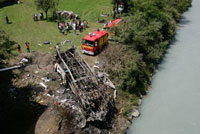Poland mourns 27 pilgrims who burned alive in terrible bus crash in France
Twenty-six Polish pilgrims were killed Sunday when a bus carrying them from a holy site in the French Alps careened off a steep mountain road, smashed into a river bank below and burst into flames, authorities said.

Click here to see the photo report of the accident
Polish President Lech Kaczynski and his French counterpart, Nicolas Sarkozy, traveled to the southeastern French city of Grenoble to meet with injured, including 14 with serious injuries. Sarkozy said he was "shattered by the scale of the tragedy," and pledged to follow the investigation into its causes "very closely."
The crash occurred around 9:30 a.m. (0730GMT) near the village of Vizille, as the pilgrims were returning from the Sanctuary of Notre-Dame-de-la-Salette, about 40 kilometers (25 miles) south of Grenoble, officials from the prefecture of the Isere region said.
Residents of the nearby town Notre-Dame-de-Mesage said the bus was speeding and missed a 90 degree bend in the road. It smashed through a barrier and fell about 20 meters (65 feet) onto the bank of the La Romanche River, shortly after bursting into flames, firefighters said.
Cesar David, a local resident, said some of the passengers were thrown from the bus, but "many were trapped inside."
"There was a series of small explosions," David said. "Then the bus went up in flames. We couldn't come near."
Philippe Baret, who owns the field where the bus landed, said he helped pull the injured and the dead out of the bus before flames engulfed it.
"When the bus was burning, there were injured people inside," Baret said. "I saw at least six of them who were stuck inside the bus and burned to death before my very eyes."
When the flames died down, the bus was left a charred frame, and bits of debris were strewn across the river bank.
Survivors were evacuated by helicopter to hospitals in Grenoble.
The count of those onboard the bus varied. Polish Foreign Ministry spokesman Robert Szaniawski said in Warsaw that 50 people were on the bus, including 47 pilgrims, 2 drivers and a guide; French media reported between 50-60 people on board.
Most were in their 50s to 70s, but there were also three children - a 12-year-old and two 13-year-olds - and several pilgrims in their 20s and 30s, said Marcin Szklarski, president of Orlando Travel, the agency that organized the pilgrimage.
They left Poland on July 10 for a two-week visit to famous sanctuaries in France, Spain and Portugal, including shrines in Lourdes, France, and Fatima, Portugal, he said in Skawina, Poland, outside Krakow.
The bus, a 2000 Scania, underwent technical checks three weeks ago in Germany. "The bus had passed its checks," Szklarski said.
Most of the pilgrims were from the Szczecin area in northwestern Poland, near the German border, said the Rev. Ryszard Kaminski of St. Nicholas Church in Szczecin.
Three priests had been on board the bus, said the Rev. Slawomir Zyga, a spokesman for the Roman Catholic Church in Szczecin. One called the church after the accident.
"He said he was shaken up and bloody, but alive," Zyga told Poland's TVN24, adding he had no information about the two other priests.
The driver who was behind the wheel at the time of the crash was killed, while his colleague survived but has yet to be questioned, local police said.
The crash sparked a wave of indignation among local residents and politicians who complained that the road had long been a safety hazard. It was the site of several other accidents involving buses: a 1973 crash in which 43 pilgrims were killed, and crash two years later that left 29 dead.
"We can't manage to make this descent safe," Jean-Jacques Defaite, the mayor of the neighboring town of Laffrey, told LCI television.
After the accidents in the 1970s, buses were required to obtain a permit to use the 8-kilometer-long (5-mile-long) road, which has a 12 percent gradient. The bus involved in Sunday's crash had no such permit, firefighters said.
Others said that speed of the bus, not the steep road, was likely responsible for the crash.
Grenoble's state prosecutor Serge Samuel told France Info radio that four motorcyclists who were following the bus for several kilometers (miles) before it plunged off the road said it was traveling at about 70 kilometers (44 miles) per hour. Experts would verify the bus' speed, he said.
During his visit to a Grenoble hospital treating some of the survivors, Sarkozy said he had "come to express to the Polish president the solidarity of all the French people in the face of this abominable catastrophe."
Sarkozy and Kaczynski, who flew in from Poland earlier Sunday, also visited a Grenoble morgue to pay their respects to those killed in the accident. Kaczynski also visited the crash site, where he lit a candle and said a short prayer, his office said.
Other French officials, including French Prime Minister Francois Fillon and his deputy prime minister, Jean-Louis Borloo, who is in charge of transportation, visited the crash site. Borloo has launched an investigation into the causes of the accident.
Fillon said he was pained by the accident, which "hit young people and older people who were coming back from a pilgrimage and should never have died" in such a way.
The Polish government was organizing a flight at 0500GMT Monday from Szczecin to Grenoble for the victims' families, Polish officials said. There was no immediate indication of how many people would be on board.
Nestled between Alpine peaks, the Sanctuary of Notre-Dame-de-la-Salette is about 1,800 meters (5,900 feet) above sea level. The complex was built on the site where two children claimed the Virgin Mary appeared to them in 1846. It has since become an important pilgrimage site, drawing Catholics from around the world.
Subscribe to Pravda.Ru Telegram channel, Facebook, RSS!


